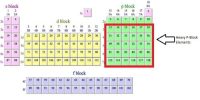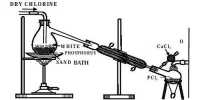Laboratory Preparation of Etching Glass: Industrially, hydrogen fluoride is obtained by heating fluorspar (CaF2) with concentrated H2SO4 in a lead vessel.
CaF2 + H2SO4 → CaSO4 + 2HF.
HF distils over and the vapours are condensed in water in a lead receiver.
Aqueous HF thus obtained is stored in wax bottles. It cannot be stored in glass or silica bottles as it attacks silicates and silica.
Na2 SiO3 + 6HF → Na2 SiF6 + 3H2O
SiO2 + 4HF → SiF4 + 2H2O
The action of hydrofluoric acid on silica and silicates is used for etching glass. The glass article is first covered with a film on wax. The design to be etched is now drawn on the waxed surface and is then exposed to the action of hydrofluoric acid. Now the glass can be very soon etched. The wax is finally washed off with turpentine.













